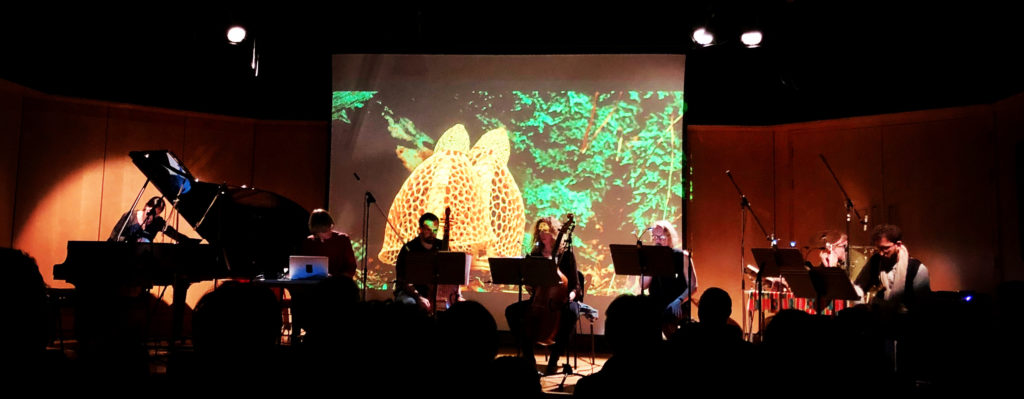Portfolio of works
- The Metalization of a Dream for open instrumentation and electronics.
- Cronan an Dain for soprano, bass clarinet and electronics.
- Diesis for double bass and live electronics commissioned by the London Sinfonietta.
A comprehensive portfolio of work can be accessed here
The Metalization of a Dream

The Metalization of a Dream is an open-form composition that draws upon Queer arts practice and the DADA and surrealist-inspired collages of the visual artists Hannah Höch and Eduardo Paolozzi. As with Höch and Paolozzi’s practice, this work montages found objects such as John Taverner’s In Nomine and the writings of Gertrude Stein that are reimagined and juxtaposed with composed and indeterminate materials to form an equivocal sound world. This post-structural approach employs John Cage’s notion of the coexistence of dissimilars, where harmoniously blended elements are eschewed in favour of sonic juxtapositions ‘that fuse in the ear of the listener’ (1961, p.12). This non-linear collaging of materials drawn from different spatiotemporal situations reveals an Otherness that looks to access the subconscious, political, and absurd.
Commissioned by Galvanize Ensemble. Premiered by Galvanize Ensemble and Fretwork at Newcastle Lit & Phil in February 2019 with funds from The RVW Trust, Arts Council of England, Britten Pears Foundation, and PRS Foundation (8-30 minutes in duration). An expanded version of the work was premiered in January 2021, as part of SOUND Music Festival, Aberdeen. To date, additional performances include Café OTO, City University Concert Series and several streamed events, namely nonclassical, NottNOISE New Music Marathon, and Lit & Phil Online. In November 2020, the work was the focus of a 1-hour radio broadcast on Resonance FM, that featured a pre-recorded performance of the work and interview.
Cage, J. (1961). Silence. Middletown, Conn.: Wesleyan University Press.
Cronan an Dain
This work is a setting of the traditional Gaelic lullaby Cronan an Dain, or Fate Croon that is thought to originate from the Hebridean island of Eigg. These lullabies, or croons as known within the Western Isles, are essentially cradle songs, the quality of which are, as the folk song collector Marjory Kennedy-Fraser describes as ‘living, moving, rhythmical germs, that have a mesmeric, wheel-like pulsation’. The subject of these croons often entwines folklore, with ritual and superstition that bring a sense of foreboding – represented here by the clarinet and electronic parts that shadow the vocal line.
Written for soprano, bass clarinet and live electronics, commissioned by Ian Mitchell and Alison Well. Premiered at SABRe Symposium, Keel University, February 2012.
Diesis
Written for double bass and live electronics. Commissioned by the London Sinfonietta, premiered by Enno Senft at Hall 1, Kings Place, London, October 2011 and featured on the album New Music Show, released in 2012 on London Sinfonietta Records/NMC (EAN: 5065000796099).
This work is an exploration of microtonal commas (a minute interval) of which a diesis, a diminished second, gives this piece its title. Historically, when tuning a scale, rather than divide an octave into equal parts (as used today with equal temperament), early tuning systems would tune notes using a sequence of pure intervals, which are slightly different in size to the equal-tempered intervals we use today. These discreet differences in pitch would result in an undesirable and perceptually dissonant imperfect octave, the interval of this imperfection being a comma. Diesis is, therefore, a response to the dissonant qualities that made a comma undesirable, namely its complex timbre and pulsing beating tones.